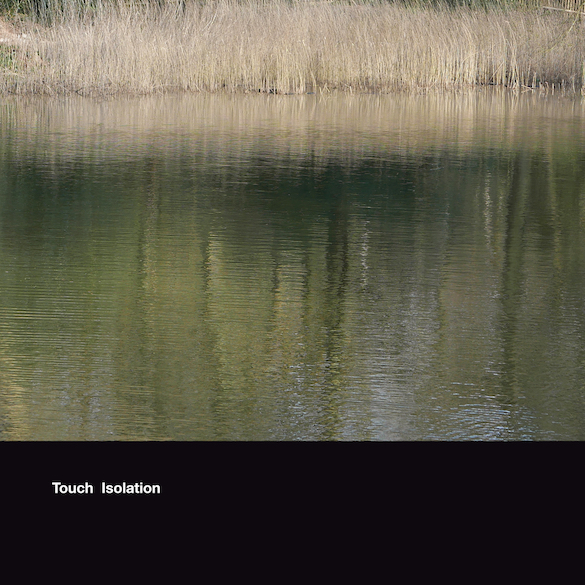CD (digipak) – 7 tracks – 55:51
Cover photography: Joséphine Michel
Art Direction: Jon Wozencroft
Mastered by Denis Blackham
Track listing:
1. Magnetia
2. Magnetotactic
3. Magnetosphere
4. Magnetosense
5. Magnetism
6. Magnetosome
7. Elvis’s TV Room
Mika Vainio, currently based in Berlin, was one half of the minimal electronic duo Pan Sonic from Finland, (with Ilpo Väisänen). Before starting Pan Sonic in the beginning of the 90’s, Mika Vainio has played electronics and drums as part of the early Finnish industrial and noise scene. His solo works, under his own name and under aliases like Ø, are known for their analogue warmth and electronic harshness. Be it abstract drone works or minimal avant techno, Vainio is always creating unique, physical sounds. He has released on other labels such as Editions Mego, Wavetrap and Sähkö and he has produced work with, amongst others, Alan Vega of Suicide, Keiji Haino, and Bruce Gilbert. Since 2009 Mika Vainio has contributed to the music for Cindy van Acker’s dance pieces…
This is his 5th album for Touch, after Onko [Touch # TO:34, 1998], Kajo TO:43, 2000], Sokeiden Maassa Yksisilmäinen on Kuningas (In the Land of the Blind One-Eyed Is King) [TO:54, 2004] and Black Telephone of Matter [Touch # TO:72, 2009].
“Fe3O4 – Magnetite” was recorded in Berlin between 2011 and 2012. In contrast to the dark vistas of his most recent releases, “Fe3O4 – Magnetite” oscillates between the two poles of silence and noise. Using his signature sources which range from radio signals to sine wave generators, Mika Vainio creates a unique emotional journey that moves from the serene to the unsettling, always challenging the listener’s comfort zone.
Buy Mika Vainio “FE3O4 Magnetite” [CD] in the TouchShop
Reviews:
The Sound Projector (UK):
Mika Vainio will be an electronic musician I personally associate with a time in the 1990s when electronica was punchy, abstract, and brutal. His FE304 – Magnetite (TOUCH TO:86) thankfully contains some trace elements of these desirable features. With six track titles that incorporate the word “magnet”, he may be trying to tell us something profound about the world, even more than these stark, ultra-dynamic throbbers of pulsant noise reveal on first spin. Angry firebursts, puzzling silences, eerie distilled silver tones, deathly precision. An air of stern grimness abounds for album’s length, which is fine, but Vainio also relaxes into pedestrian mechanical drone once too often for my liking. ‘Elvis’s TV Room’ is a great title though, and it’s a good piece of mausoleum music too.
Other Music (USA):
Unlike some of Mika Vainio’s recent solo releases, which tended to truck in darker and more foreboding soundscapes, FE304 – Magnetite is a blissful exercise in exploring the opposing forces of sound, from crisp, quiet minutia to rough-edged washes, the poles of silence and noise. Using mostly radio signals and sine wave generators as his source material, Vainio takes the listener on a strangely emotional journey that stretches both the ears and the imagination.
Boomkat (UK):
There are few contemporary musicians who have had as much of an impact on us as Mika Vainio, so each new release is always cause for celebration. Whether exploring the grim underbelly of the electric guitar on ‘Life (… It Eats You Up)’ or haunted minimalism in his collaboration with Kevin Drumm and friends on ‘Venexia’, Vainio somehow manages to throw us into a state of awe consistently time and time again. ‘FE3O4 – Magnetite’ manages to uphold this quality but takes a stylistic about turn, exploring the two poles of noise and silence, finding Vainio explore distortion and contrast in a way he hasn’t for many years now. Radio static emerges from almost nothing, sounds appear for a second and are gone and cables are established and removed without warning. This dynamic is offset by Vainio’s well-documented expertise with very loud drones, and the drones we’re treated to on ‘FE3O4′ are louder and more intense than you’re likely to find almost anywhere else. Sub bass tones tear through the silence heralded only by small pops, and wavering, distorted oscillators cut and slice like a lone machete in a dark night. This is often terrifying music, but thanks to Vainio’s calm hand it never devolves into mere theatrics. Rather the sounds are so well paced and expertly handled that you feel like you are being treated to the work of a pioneer, and someone whose work is a direct descendent of Bernard Parmegiani, Luciano Berio and Throbbing Gristle. Incredible music, and yet another totally unmissable full-length from Mika Vainio.
Norman Records (UK):
Vainio is back with his fifth album for the esteemed Touch label. if you’re not massively familiar with his work then he’s the king of dark sonic processed sounding sounds. I’m six minutes through the first track ‘Magnetia’ and I’m getting a dark sonic distorted fuzz which is foreboding and making me feel possessed.
Onto ‘Magnetotactic’ (all the tracks start with “Mag”…except the final track ‘Elvis’s TV Room’) and it’s chock full of strange noises, beeps and sounds. The album continues with disjointed crazy electronic soundscapes full of some of the oddest noises I’ve heard in a while. In between the dark fuzz, minimal tones and electronic pulses and throbs are acres of of sonic space where nothing much happens. It’s far from an easy listen but those who are fans of the Vainio will find this much fun.
The Milk Factory (UK):
Mika Vainio was once one half of Finnish exploratory duo Pan Sonic until he and Ilpo Väisänen decided to part for good after fifteen years two years ago, but this ever only represented one facet of his work. As well as contributing to a good few other formations, he has released a number of records under a variety of monikers, perhaps the best known of which, beside the music published under his own name of course, is Ø, a project he pursues to these days. Fe304 – Magnetite is his tenth solo record as himself, his fifth for Touch.
Over the years, Vainio has extensively experimented with noise and silence in various forms and to various degrees. With his last album, Life (.. It Eats You Up), published last year on Editions Mego, he turned his attention to the electric guitar (processed, treated and textured), which provided the majority of his sound sources and gave him the opportunity to experiment with distortion and feedback in a different way to his usual set up. Fe304 – Magnetite is a much more contrasted affair. Returning to the familiar post-industrial sound sources that have been at the core of his work for two decades, he explores an incredibly vast dynamic range, focusing essentially on the sonic regions between complete silence and extreme noise. Vainio assembles minimalist tableaux from rarefied percussions, scattered electronics, distant radio signals and statics reminiscent of early stripped down forms of musique concrète (Magnetica, Magnetosome), to which he occasionally adds haunting sounsdscapes (Magnetosense). These minimal structures can sometimes develop almost imperceptibly for a number of minutes before they are torn apart by a devastatingly powerful sub-bass or a stab of distortions, often with little to no warning (Magnetostatic).
Often though, Vainio generates tension by creating an expectation that, at any point, the listener may be subjected to a high level of noise, but never actually realising it. This is a technique that has used on many occasions throughout his career, but it has been some time since Vainio has played on this to such extend. Fe304 – Magnetite contains some pretty intense moments of noise, but these are comparatively few and far between compared to the vast sprawls of atmospheric or minimal constructions he deals with here. It feels as if, because of these almost constant expectations that a storm is brewing somewhere, this album deals with silence and noise in equal measure. This is not the case. Vainio manages to convey the idea of noise even when he refrains from going anywhere near it, and this infuses throughout one of his most unnerving records to date. 4.3/5
Black Audio (blogger):
With a credible history with the legendary minimalistic Pan Sonic, Berlin based Mika Vanio has found himself releasing a number of solo projects of late, alongside working within the Finnish Industrial and noise scene. It is of no surprise then that ‘Fe304-Magnetite’ starts off with a fair amount of minimalism in its own right; light droplets of sound that are interrupted with off key drones and machine head bass electronics. Whilst as clever as the first half of this album is, it isn’t until the glorious ambient beauty of ‘Magnetosense’ makes its appearance on track four that things really become interesting. Drones float away into breathing, resonating clarity and a cold wave of emotion is left for the listener to capture their own thoughts. For the most part, there is a purity to this album that I relish. When Vanio takes time to stop what could be deemed as tomfoolery, he does set apart a space where residual electronics can capture your thoughts and hold you in a small vacuum of hypnosis. The only aspect letting him down in a lot of respects, are the frequent self-indulgences of art taking precedence over actual music. This is in turn a real pity, as when Mika really sets his mind to it, his compositional qualities shine a very bright torch indeed.
Improv Sphere (France):
Mika Vainio était l’un des membres du duo finlandais Pan Sonic, un duo de musique électronique minimale formé au milieu des années 90. Je ne connais pas très bien la musique de ce duo, ni les projets solo de Vainio. De chacun, j’en ai entendu quelquefois, mais je ne me rappelle que du récent – et excellent – quartet auquel a participé MV, aux côtés de Capece, Dörner et Ankersmit.
Pour FE304 – Magnetite, composé et enregistré à Berlin entre 2011 et 2012, MV propose une musique électronique étrange et très personnelle, complètement hors des sentiers battus. Il s’agit d’une musique grave, lourde, souvent sombre et pesante. Une musique parfois noise et corrosive, parfois ambient, dark, doom, industrielle, mais toujours électronique, de l’électronique propre et lisse, unique en son genre. Une musique qui peut être très linéaire ou qui peut posséder des accents industriels lentement rythmés, dans des ambiances lisses et analogiques, ou abrasives et saturées. Les sonorités de MV possèdent toutes une touche très singulière, il y a toujours un accent qui les écarte de ce que l’on pourrait attendre. Et c’est ce que semble rechercher MV, aller contre attente. Car les sept pièces qui constituent FE304 – Magnetite semblent toutes partir d’une idée longuement exploitée, de manière continue et stable, avant d’être rompue et fracturée par un autre univers qui n’a plus rien à voir. Les univers se succèdent sans prendre en compte ce qui a eu lieu précédemment. Dès que l’on se conforte dans une des multiples nappes minimales et linéaires proposées par MV, celui-ci s’empresse d’y mettre fin et de passer à tout autre chose, à un autre territoire sonore sans lien logique avec le précédent.
Toujours: des textures et des ambiances très recherchées, et surtout inattendues. MV sait envoûter par l’originalité et/ou la beauté et la clarté de ses sonorités, mais il sait surtout surprendre l’auditeur grâce aux structures adoptées. Une surprise inconfortable, mais qui place aussi l’auditeur dans une position d’écoute active, aux aguets, une position de questionnement et d’attention.
En tout cas, la musique de MV est ici très recherchée, les nappes et les textures sont d’une clarté, d’une propreté et d’une originalité plutôt remarquables et souvent jouissives. Quant à la structure, hors du commun, fracturée et allant contre attente, dans des zones parfois inconfortables et risquées, on ne peut nier son inventivité et sa créativité, et ce malgré quelques longueurs – longueurs qui semblent être là volontairement pour participer à placer l’auditeur dans une zone inconfortable où il ne peut rien prédire, inconfortable mais unique! Une musique précieuse, paysagère, sombre et onirique (ou cauchemardesque parfois), mais surtout inventive.
de:bug (Germany):
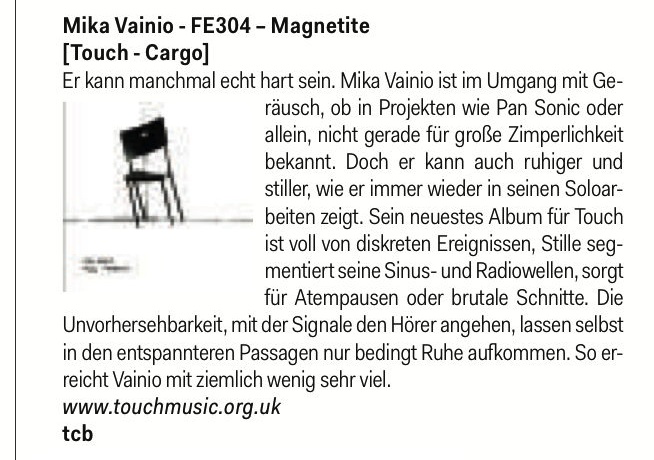
nowamuzyka (Czeckia):
„To nie jest krzesło”. Okładka albumu Vainio zachęca do sparafrazowania tytułu obrazu René Magritte – dzieła, które można traktować jako zapowiedź praktyk konceptualistów. Joseph Kosuth, uważany za protoplastę tego artystycznego nurtu, stworzył słynną pracę „Jedno i trzy krzesła” – zestawiając obok siebie mebel, jego fotografię i słownikową definicję. Pragnął postawić tym samym pytanie o znaczenie i zasadność pojęć oraz przedstawień w odniesieniu do ich materialnych odpowiedników.
Mianem konceptualnego można określić album „FE3O4 – Magnetite”, co sygnalizuje już sam tytuł. Magnetyt (Fe3(Fe2+Fe3+)O4) – za wikipedią – to „minerał z gromady tlenków, zaliczany do grupy spineli (żelazowych). Należy do minerałów bardzo pospolitych i wyjątkowo szeroko rozpowszechnionych”. Występuje między innymi w powłoce magnetycznej taśm magnetofonowych, w dyskietkach i dysku twardym. Tytuły poszczególnych utworów odnoszą się do zjawisk fizycznych i chemicznych, rozpoczynających się tym samym członem „magnet”. W jaki sposób Vainio próbował oddać poprzez swoje kompozycje ich charakter – trudno jednoznacznie stwierdzić. Czy muzyka to odpowiedni kod do wyrażenia takich terminów jak magnetostatyka, magnetosfera czy magnetosom? Czy jej abstrakcyjność lepiej oddaje ich istotę, niż słownikowe definicje?
Brzmienie Fina, wywodzącego się z kultowej grupy Pan Sonic, jest rozpoznawalne od pierwszych sekund. Prezentuje on styl oszczędny, bazujący na palecie chłodnych, metalicznych barw. Fale sinusoidalne, wyabstrahowane mechaniczne tony, szumy radiowe, głębokie basy – to tylko wycinek leksyki Vainio. Artysta niczym chirurg tnie dźwięki, z zimną precyzją dokonuje operacji na wrażliwej tkance. Cięcia w przypadku tego albumu są istotnym środkiem wyrazu; następują gwałtownie, przerywając bloki hałasu kującą w uszy ciszą. W magnetycznych trackach pojawiają się doom metalowe wstawki pod postacią rzężenia gitarowych wzmacniaczy, co dodaje smaku sterylnej całości.
Otwierający płytę utwór „Magnetica” skonstruowany został na tym kontraście; rytmiczne drewniane uderzenia i pocieranie perkusyjnych talerzy zalewa masa napięcia, dobywająca się z przetworników elektromagnetycznych gitary. Rozpiętość pomiędzy ciszą a hałasem artysta testuje również w „Magnetotactic” i „Magnetism”, gdzie zestawia elementy podskórnych pulsacji z głośnymi, nicującymi częstotliwościami. Po stronie ciszy i skupienia można zaś umieścić najciekawszy w tym zestawieniu „Magnetosense” – rozpoczynający się od metalicznych ukłuć, rozwijający field recordingowym fragmentem, stopniowo przekształcanym w elegijny dron.
„FE3O4 – Magnetite” to kolejny tytuł w katalogu Vainio utrzymujący wysoki poziom, do którego fiński artysta zdążył już przyzwyczaić swoich słuchaczy. Ciekawa narracja, chłód i wyrafinowanie, nawał dźwięków i uspokojenie – tego można spodziewać się po najnowszym albumie wydanym nakładem Touch. [Michał Fundowicz]
kindamuzik (Belgium):
Eind vorige eeuw zette de in Berlijn residerende Fin Mika Vainio met het duo Pan Sonic de krijtlijnen uit voor een vernieuwende benadering van minimalistische elektronische muziek. Solo gaat Vainio op een soortgelijke manier verder en dat doet hij zowel onder zijn eigen naam als onder de pseudoniemen Kentolevi, Philus, Tekonivel en Ø. Momenteel is overigens alleen de laatstgenoemde nog actief.
In Vainio’s continue zoektocht naar een balans tussen melodie en abstracte geluiden slaat Fe304 – Magnetite naar de tweede component door. De tegelijkertijd asymmetrische en strakke stoel die op de cd-hoes prijkt, geldt als metafoor. Tijdens deze muzikale reis wil Vainio met een arsenaal elektronica een nieuwe dualiteit tussen stilte en geluid creëren.
De hoge mate van abstractie blijkt eveneens uit de naamgeving. Wat te denken van songtitels als ‘Magnetia’, ‘Magnetotactic’, ‘Magnetosphere’, ‘Magnetosense’, ‘Magnetism’ of ‘Magnetosome’? Bovendien noemde Vainio de cd ook nog eens Fe304 – Magnetite, dus het zal weinig verbazing wekken dat de composities variaties op hetzelfde thema zijn. Enige uitzondering is de afsluitende track, ‘Elvis’s TV Room’, die initieel meer lijkt aan te sluiten bij de duistere drones van bijvoorbeeld Sunn O))). Na enige minuten gaat Vainio echter creatief aan de slag en verknipt hij het nummer tot een elektronische lappendeken waarop hij zijn muzikale initialen borduurt. [Hans van der Linden]
The Liminal (UK):
Like the snow that coats his native Finland for large portions of the year, the music of Mika Vainio is cold and severe, a sub-zero take on the archetypes of electronic music. Here releasing himself from the rhythmic anchor of Pansonic, Vainio deploys sheets of caustic digital noise interspersed with lengthy passages of uneasy near-silence. ‘Magnetotactic’, one of the album’s highlights, is a case in point, as metallic drones make way for the occasional piercing bleep of what sounds like a digital watch. On the more restrained ‘Magnetosense’, he swerves into classic ambient with ghostly synth melodies and deep basslines providing a brief respite from the unpredictable onslaughts that pop up on the rest of the album. Vainio seems to expand on this delicacy on “Magnetism” but quickly deconstructs his sounds via brutally abrasive feedback, as if he has just plugged his laptop into a collapsing generator during a jam with Kleistwahr and Pete Swanson. As ever with Vainio, Fe304 is not for the fainthearted, because even at its most becalmed it constantly threatens to explode with nice cold aggression. [JB]
Nordische Muzik (Germany):
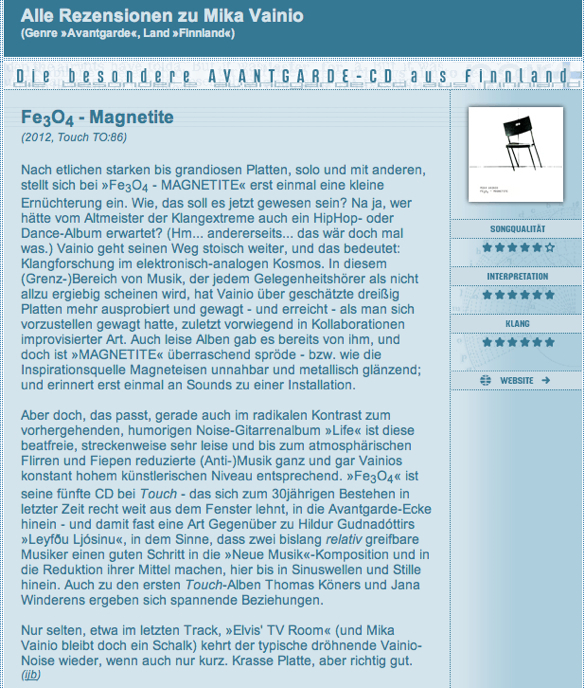
Whisperin’ & Hollerin’ (UK):
Mika Vainio’s last album, ‘Life… It Eats You Up’ was a devastating work of sinister sonic brutality. ‘FE304 – Magnetite’ expands on the sonic territory, exploring more the quieter, minimal elements of its predecessor and revisiting some of the aural geology mapped out by Vainio while working with Ilpo Väisänen as Pan Sonic.
FE304 – Magnetite is also known as black iron oxide, and is a natural magnet. It’s an apt title given the way Vainio incorporates organic elements and warm analogue tones alongside harsher, digital sounds to forge his compelling soundscapes. ‘FE304 – Magnetite’, then, is richly textured, and on ‘Magnetia’, builds from soft, delicate sounds to a low, menacing hum with a serrated edge. Chiming sounds and spells of near silence contrast with barrelling surges of power electronics, and repeatedly throughout the course of the album, Vainio builds tension and then annihilates it in thunderous waves of sound.
Shuddering shards of metallic treble grate and scrape to carve nighmarish soundscapes, while dense, distortion-tinged drones buffet through ‘Magnetosphere’. ‘Magnetosense’, on the other hand, confounds expectations by tapering lightly through a vaporous trail of ambience. It segues into the rumbling pulses and eerie quietness of ‘Magnetism’ that eventually gives way to menacing doom and industrial earthworks.
It’s only the final track, ‘Elvis’ TV Room’ that deviates from the ‘magnetic’ theme, and sonically, it stands apart, too. Tweets and flutters break the silence along with a collision of found material. And then there is nothing. [Christopher Nosnibor]
Titel (Germany):
Ex-Pan Sonic-Mitglied Mika Vainio fügt seiner umfassenden Diskografie mit FE304 ein weiteres Album hinzu. Vainio, der bisher kaum eine experimentelle Spielart unprobiert gelassen hat, präsentiert auf sieben Tracks mit einer Gesamtspiellänge von knapp 56 Minuten einen geradezu entmenschlichten Sound. Einzelne Klänge, statisches Dröhnen und oszillierende Mehrklänge bedrängen und überlagern sich, lassen sich Raum und verklingen wieder. Als hätte Vainio die innere Dynamik eines im langsamen Strom befindlichen Eisschollenfeldes in einen sterilen Sound transformiert.
FE304 ist dem titelgebenden Mineral ähnlich kalt und leblos, aber auch vielseitig und irisierend. Ein Seiltanz zwischen den Polen Stille und Klang, über dem Abgrund einer großen Depression. Ein besonderes Album, dessen scheinbare Wahllosigkeit sich mit ein wenig Aufmerksamkeit schnell als grundlegendes Stilmittel erkennen lässt. Aus der klanggewordenen totalen Entfremdung wird man dann unsanft heraus befördert: Elvis‘s TV Room endet auf einem hohen Fiepen, unerträglich und eigentlich unmenschlich. Ein verstörendes Finale eines nicht minder aufrüttelnden Albums.
Dissolve (France):
Depuis la mise en hibernation prolongée de Pan Sonic, le Finlandais Mika Vainio a fait feu de tout bois, explorant sur un nombre croissant de publications en solo un spectre musical de plus en plus étendu. Frôlant de près les climats industriels sur le EP Vandal, il s’empara ensuite des tropes du métal pour Life (… It eats you up), avant de revenir avec FE3O4 – Magnetite (rien à voir avec le FE2O3 de Mlada Fronta si ce n’est un goût commun pour les oxydes de fer) à des atmosphères plus proches de ses albums antérieurs. A l’aide de son attirail sonore habituel (oscilloscopes, radios…), d’effets minimalistes et de field recordings, Mika Vainio dessine avec FE3O4 – Magnetite les contours érodés de formes indistinctes évoluant entre des blocs de silence et des attaques sèches. Instables, pouvant s’effondrer à tout moment, les sept titres de l’album peuvent ainsi commencer de manière très minale pour s’orienter ensuite vers une noise râpeuse (« Magnetica », et plus encore « Magnetism » qui joue de la micro-coupure pour faire s’écrouler l’édifice), agréger un paysage de drones grisés (« Magnetosense »), insérer un sentiment d’inquiétude dans des résonances de bols tibétains (« Magnetosome ») dévorées par des captations de mélodies éraillées, ou opposer directement noise et silence dans un « Elvis’s TV Room » qui passe sans le moindre signe avant-coureur de l’un à l’autre. Ardu, taiseux à l’image de son auteur, FE3O4 – Magnetite est un album qui ne cherche pas à faire de cadeaux à l’auditeur, semble se moquer comme d’une guigne de son éventuelle présence d’ailleurs. Il existe, c’est tout, dans un espace intermédiaire ouvert par Mika Vainio. Peu importe sous quel angle nous pouvons parvenir à l’apprivoiser, cela n’en diminuera en rien sa puissance.
Igloo (USA):
Music comes in many forms. It can waft past your ears without a care in the world, barely tickling your eardrums with interest. It can be too saccharine, too twee, too irritating—syrup-ing around your aural canals like a petulant teenager. It can be beautiful, uplift, bring people together and all that self help guff. It can also challenge, terrify and confuse—just some of the territories this latest release from Mika Vainio inhabits. Testing the outer reaches of both silence and noise, Vainio explores each with exacting detail—magnifying their claustrophobic qualities with sound sources culled from sine wave generators and radio signals.
Things start quiet with a reverb drenched woodblock tap before a sudden wall of distorted noise hammers the auditory cortex with a brutal ferocity and sound so present it’s right up in your face nudging your eyeballs. Lulls crop up throughout—bestowing a false sense of security as metallic reverberations and gentler audio manipulations form moments of beauty. Before you know it, further heavy duty distortion hoovers the wax from the lower reaches of your lug holes and squirts it all over the walls leaving you staring wide-eyed at the speakers trying to work out what just hit you.
It feels like Vainio is plugged directly into my apartment’s electrical system, conjuring up static demons—blasting them through the ether and dispersing the terrified air with blackened sound waves. At times it appears there are human voices trapped within the racket—desperate screams attempting to exit the merry hell spewing forth.
Terror inducing atmospherics aside, Magnetite is a marvelous snarling visceral work. Fans of fearful heavy drone plus Tim Hecker, Keith Fullerton Whitman and Ryoji Ikeda style sound art experiments will be enthralled.
Jahrgangsgeräusche (Germany):
Das Ohr ist nah dran an der oszillierenden Welle. Ganz nah dran. Im ersten Moment möchte man vor Schreck und in Anbetracht des hohen Drucks unwillkürlich einen Schritt zurücktreten. Doch sogleich schlägt einen die Genauigkeit der Darstellung in ihren Bann. Die Welle brummt und kratzt. Ihre Textur lässt sich im Geiste mikrometergenau nachzeichnen, so also würde man mit einem Mikroskop über dem magnetisierten Band hängen.
Dann genau im richtigen Moment ist die Welle verschwunden und ein nur scheinbar vergessenes Zirpen markiert den Raum. An- und Abschwellen. Filterungen werden mit betonter Langsamkeit zur Demonstration. Fragmente, zuweilen aus Radio-Mitschnitten werden transformiert, werden abstrahiert. Kleine Dinge werden durch die Lupe betrachtet und erlangen große Bedeutung. Vermeintlich große Themen hingegen werden nur kurz erwähnt und zum Break degradiert. Der inzwischen auch in Berlin lebende Finne Mika Vainio macht mit „Fe3O4-Magnetide“ konsequent da weiter, wo er 2010 mit „Time Examined“ begonnen hat: mit der Aufladung des Ereignisses Wellenform.
Oszillationen und Filter werden zu Protagonisten einer klanglichen Abstraktion, die es immer wieder schafft für kurze Momente unbearbeitete Fragmente aufblitzen zu lassen. Erfreulich ist insbesondere, dass Vainio es gelingt die scheinbare Unvereinbarkeit von Maschinenhaftigkeit und Meditation mit guten Argumenten in Frage zu stellen. Ein Fragestellung, die jahrzehntelang kaum jemand im Industrial zu behandeln wagte. Uneingeschränkt meisterhaft.
“Fe3O4-Magnetide” ist im September 2012 bei Touch erschienen. [Akel Ganz]
Ondarock (Italy):
Si immagini di scorrere fra le sperimentazioni di Cage e Stockhausen, passando per la musique concrète del GRM di Schaeffer, la musica cosmica più estrema, il noise, l’industrial, la minimal-techno, il glitch e le recenti avanguardie elettro-acustiche. Si fondano ora tutti gli elementi facendoli reagire in un unico altoforno, dove si amalgamino e ne escano in un prodotto unico: si otterrà così Fe3O4.
C’era una volta Mika Vainio, ci furono una volta i Pan Sonic. Il finlandese, terminato il percorso al fianco del connazionale Ilpo Väisänen, si è dato ad un’attività poliedrica, spaziando da memorie dell’antico incantesimo avant-minimale a digressioni nell’oscurità dell’ambient-drone. Ma questo nuovo disco, che segue di un anno il precedente, nostalgico “Life (…It Eats You Up)” è lontano anni luce da qualsiasi esperienza precedentemente affrontata dall’artista, nonché da qualsivoglia forma di classificazione.
Il soggetto su cui il concept si basa (e la cui formula chimica da il titolo all’album) è la magnetite, ovvero il minerale con il più alto tenore di ferro e con le massime proprietà magnetiche esistente in natura. Queste caratteristiche si ripercuotono in toto nel sound del disco, che pare volerle descrivere e musicare: non c’è strumento musicale, melodia, ritmo o struttura, ma solo un flusso vagante e instabile di onde sonore, fruscii, campionamenti, disfunzioni, field recordings e rumori di oggetti quotidiani; il tutto, ovviamente, processato poi mediante l’ormai “classico” laptop, a definire un ambiente metallico e ostico, ma al tempo stesso carico di un’incredibile forza attrattiva.
Il proemio introduttivo è affidato a “Magnetica”, che si apre e chiude all’insegna di un silenzio rotto solo da leggeri rintocchi e da sinusoidi in libera rarefazione, prima che a metà brano esse non si mutino in siluri impegnati nello sfondare un muro di bassi ridescenti. “Magnetoactic” viaggia tra una frequenza scalfitta da lividi bleeps e un contorto reticolo di apocalittiche distorsioni, mentre “Magnetosphere” si vota in toto ad un elettronica primordiale, sviluppando la simbiosi tra silenzio e rumore attraverso campionamenti vocali, minuti interi di vuoto sonoro e improvvise catarsi di furiosi e terrorizzanti droni metallici, apparenti estratti da una colonna sonora per il più spaventoso dei film horror. L’alienante “Magnetism” cresce invece per cinque minuti filati tra pulsioni impercettibili e stridori fantascientifici, prima di eruttare in un glitch vorticoso e vibrante. La tempesta di field recordings di “Magnetosome” e il conclusivo pastiche di interferenze radio, siluri fendenti e samples atonali di “Elvis’s TV Room” – unico brano a non portare nel titolo un riferimento alla magnetite – chiudono alla perfezione il cerchio, dal quale resta esclusa la bellissima “Magnetosense”, che condede una sorta di pausa a metà lavoro cullando i sensi all’insegna di un ambient-drone ciclica e ipnotica.
Disco intriso di coraggio ed estremismo, fra le release più inaccessibili degli ultimi anni di avanguardia, “Fe3O4 – Magnetite” è un autentico trattato che convoglia anni di ricerca, aggiornando le sperimentazioni dei padri dell’avanguardia con le evoluzioni subite dalla stessa nel trascorrere del tempo. È sintesi e connubio di ricerche, esperienze e sentieri che hanno fatto la storia, forte della capacità di aggirarsi con eleganza nei più estremi confini del concetto stesso di musica.
Dusted (USA):
Amongst the ironies of Panasonic (later Pan Sonic) — the name that Finnish electronic musicians Mika Vaino and Ilpo Väisänen gave to their long-running and recently retired musical project — is this fact: While it implied an involvement with all sounds, they sure took their time getting beyond the elements of beats and tones. And to the very end, no matter how far they strayed from those essentials, they always returned to them. Vainio’s efforts under the name Ø could be even more reductive, while his work under his own name has tended toward extremes of loom and crumble; his last solo album Life (…it eats you up) is a massively heavy abstraction of guitar rock.
His new release, Fe304 – Magnetite, makes good on the Panasonic promise. Vainio seems comfortable using almost anything. At different points during its passage you’ll hear a solitary wood block, a clicking movie projector, a cymbal, a field recording of distant mall music, a shortwave radio not quite tuned into a station, some massive synth bass, and some flaking granite guitar noise. Beats, however, are pretty thin on the ground. In keeping with his past minimalist approach, sounds often appear in isolation, but Vainio seems more willing to overtly intervene with them; much of “Magnetosome,” for example, seems to be made out of stretched and transformed bell tones.
His taste in sounds and sense of what to do to them is unimpeachable, but the album’s greatest strength is its resistance to categorization. It has noisy moments, but it’s too spare to be noise. It uses field recordings, but not in a documentary fashion. It’s too uneasy and abruptly changeable to be ambient music, despite having long passages where things happen slowly. And while some of those long passages feel like slides mounted in a catalog of sounds, there is a spot tucked into the back end of “Magnetosense” that sounds like spooky movie music. What is this stuff? Hard to say, but that’s what keeps me coming back. [Bill Meyer]
Obskur (Germany):

Resident Adviser (USA):
Mika Vainio is a Finnish sound artist perhaps best known for founding Pan Sonic in the 1990s along with partner Ilpo Väisänen. He also has an extensive solo discography, releasing under his own name, Ø, Philus and other aliases, for labels like Editions Mego and UK experimental imprint Touch. It’s the latter that will release FE3O4 – Magnetite, Vainio’s fifth LP for the label and tenth solo LP overall, following 2011’s Life (… It Eats You Up) for Editions Mego. This one was recorded in Berlin (where Vainio currently resides) over the course of the past year, made with his usual array of “radio signals [and] sine wave generators” and featuring long stretches of near-silence punctuated by bursts of noise and abrasive sounds. The album consists entirely of previously unreleased tracks.
Resident Adviser (USA):
Mika Vainio is a Finnish sound artist perhaps best known for founding Pan Sonic in the 1990s along with partner Ilpo Väisänen. He also has an extensive solo discography, releasing under his own name, Ø, Philus and other aliases, for labels like Editions Mego and UK experimental imprint Touch. It’s the latter that will release FE3O4 – Magnetite, Vainio’s fifth LP for the label and tenth solo LP overall, following 2011’s Life (… It Eats You Up) for Editions Mego. This one was recorded in Berlin (where Vainio currently resides) over the course of the past year, made with his usual array of “radio signals [and] sine wave generators” and featuring long stretches of near-silence punctuated by bursts of noise and abrasive sounds. The album consists entirely of previously unreleased tracks.
Aquarius Records (USA):
The bruised Mika Vainio that was photographed on the smoldering 2011 solo album Life (… It Eats You Up) has mellowed out from the caterwauling guitar destruction and amphetamine-driven electronic noise to produce a reductionist album of electro-acoustics in Fe3O4. With the major exception in the aforementioned Life (… It Eats You Up), Vainio’s solo work under his given name aligns neatly with the decentered abstraction that Touch has always been known for (e.g. John Duncan, BJ Nilsen, Thomas Koner, The Hafler Trio, etc.), with the blistered post-techno rhythms of Pan Sonic being deflated into a solitary muffled thump or a Geiger counter click punctuating his nocturnal experiments with power-drone stasis, power-grid hums, and slumped silence. Vainio draws inspiration here from the vast allegorical properties of iron. The directionality of a pre-GPS compass, the ability to store data through ferric oxide on magnetic tape, and the corrosion of steel all speak through Vainio’s spacious compositions with often sublime, subtle results. “Magnetia” opens with the slashing acoustic rasp from a bowed cymbal akin to the classic Organum sound that collapses under the weight of a linear rumbling frequency. Ghostly utterances of searing noise slide out subdued space-time ambience on “Magnetotactic” and “Magnetism” as almost heavily dubbed versions of his previous album. The album’s finale – “Elvis’s TV Room” – eschews the magnetic metaphors even as it follows suit with the other tracks of eerie calm, blustery noise, and minimalist gestures.
Black (Germany):
After Mika Vainio and Ilpo Väisänen his partner have decided the joint project PAN SONIC (formerly PANASONIC) let rest for now, both are increasingly traveling solo. Where Ilpo Väisänen with SCHNEIDER TM under the banner ANGEL seeks more collaboration, Mika Vainio surprised last year with the brutal guitar feedback-album “Life (… It Eats You Up)” on Editions Mego. But now he returns with “FE304 – magnetites” again back in familiar PAN SONIC realm and leaves old analogue equipment humming crackling cold, and creak.Recorded in Berlin 2011-12, the only info is inside the minimalist design digipack and somehow it sounds to me like a threat! The total of 7 tracks with their great acoustic spaces commute then threatening between silence and noise, let images of vacant industrial sites or frosty cold stores in the head and caused extremely disturbing. This also struck me suddenly an old anecdote, as I have with a friend a few years ago along the PAN SONIC box “Kesto” heard and his son found it completely dumbfounded, that sounds so death must! More you need to say this, probably no more or? [Marco Fiebag]
Dark Entries (Belgium):
Mika Vainio behoeft in het wereldje van de experimentele electronica nog nauwelijks introductie. Na een carriere in de finse underground was hij lid van het duo Pan Sonic en ondertussen heeft hij er een hele serie solowerken en collaboraties op zijn palmares staan. Een grote naam met veel weerklank; en dan wordt het gevaarlijk… Na Black Telephone of Matter is dit zijn 5de album voor Touch en niet direct zijn beste. Hij laat de nogal donkere sfeer van zijn vorige Touch-album achter zich en gaat nu voor meer variatie. Gevolg is dat de kwaliteit van de stukken nogal schommelend is. Het merendeel van de tracks is echter nog prima en het blijft boeiend om te horen hoe hij met het element (of is het hier een instrument) stilte omgaat. Wat dat betreft is opener Magnetia een zeer goede inleiding bij de opzet van dit album. Zelf heb ik een zwak voor Magnetosome, wegens het gëinspireerde gebruik van -elektronisch gemodifieerde- zingende klankschalen. Ook sluitsteen Elvis’s TV room is een earcatcher, al was het maar omdat het op vlak van compositie een heel andere kant op gaat dan de rest van het album. Wanneer Vaino voor zijn volgende album meer de richting van dat laatste nummer uit gaat dan verhoog ik volgende keer met plezier de score…!
NONPOP (Germany):
Es lebe das Experiment! So oder so ähnlich könnte man das Album „FE3O4-Magnetite“ von MIKA VAINIO kurz und bündig einordnen. Ausgehend vom Albumtitel, der Bilder von Magnetfeldern oder auch von fließendem oder nicht-fließendem Strom, mit dessen Hilfe Magnetfelder aufgebaut oder beeinflusst werden, heraufbeschwört, findet man sich in einem minimalistisch, elektronisch-experimentellen Umfeld wieder, in dem immerfort die Spannung zwischen leise und laut ausgelotet wird.
In rein instrumentalen Anordnungen der Tonerforschung, die kein typisches Songformat aufweisen, klackert es mal hier und tickt es mal dort. Verzerrte analoge Töne brechen sich Bahn. Es rauscht und knistert. Klare Sinustöne bestimmen hier und da das Bild. Der besondere Klang, der besondere Aufbau, der die Sache kreativ nach vorne bringende Part – das fehlt. Analoge Spielerei auf diesem Niveau dürfte mit entsprechenden Gerätschaften jedenfalls wohl jeder einigermaßen hinbekommen.
Vorstellbar ist dieses Album somit als Hintergrundbeschallung für eine technische oder eventuell auch passende Kunstausstellung – als akustische Atmosphäre für die Unterstützung der visuellen Sinneseindrücke. Ansonsten bleibt es eher schwierig, mit so einem Album etwas anzufangen, da nichts bleibt, nichts hängenbleibt, nichts emotional berührt.
Mehr gibt es nicht zu sagen? Nein, und das ist vielleicht auch das Problem.
GO MAG (Spain):
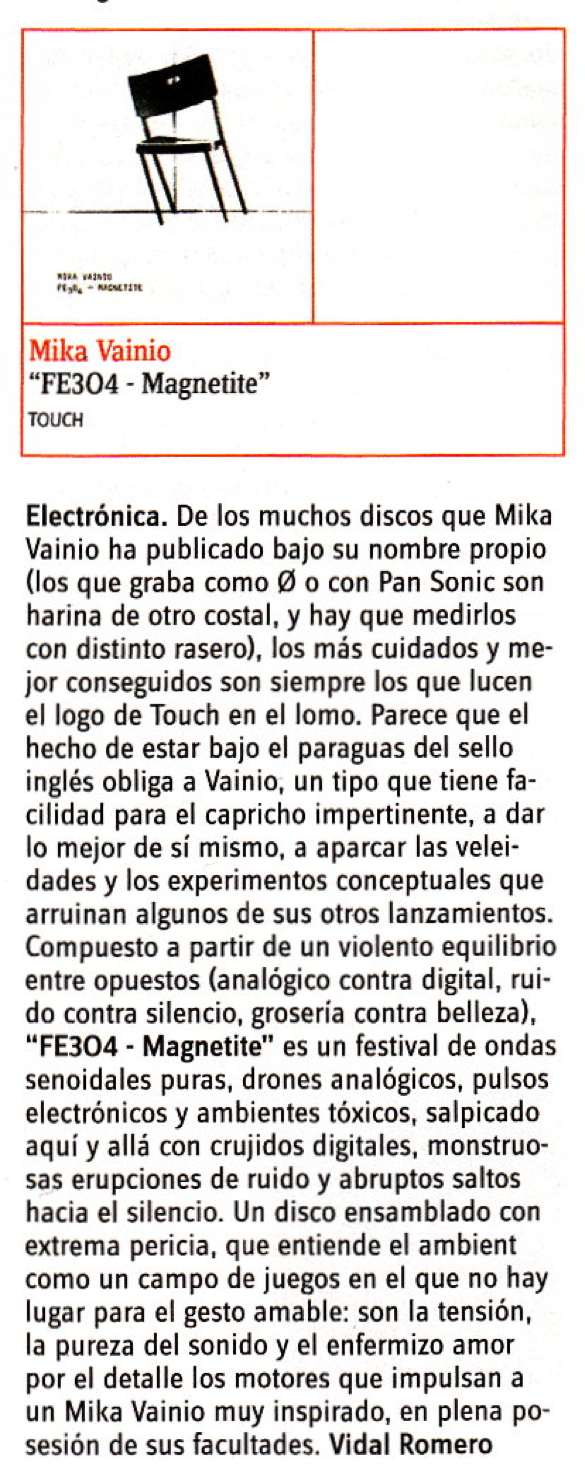
Rock-a-Rolla (UK):
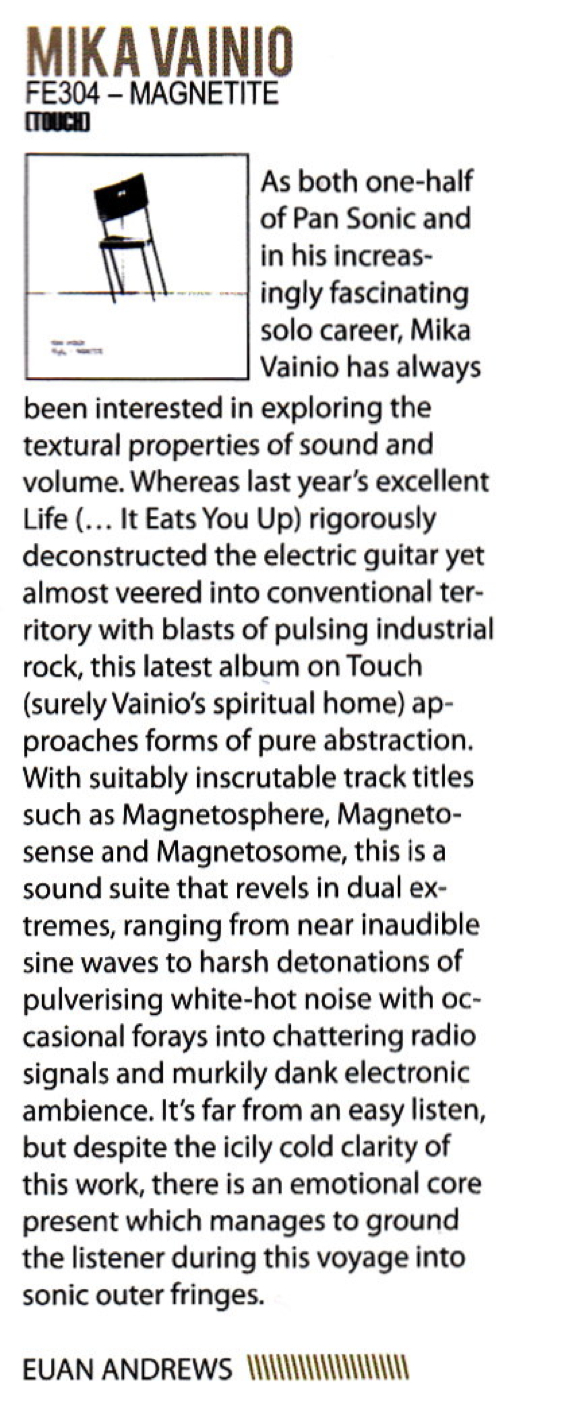
Gonzo Circus (Belgium):
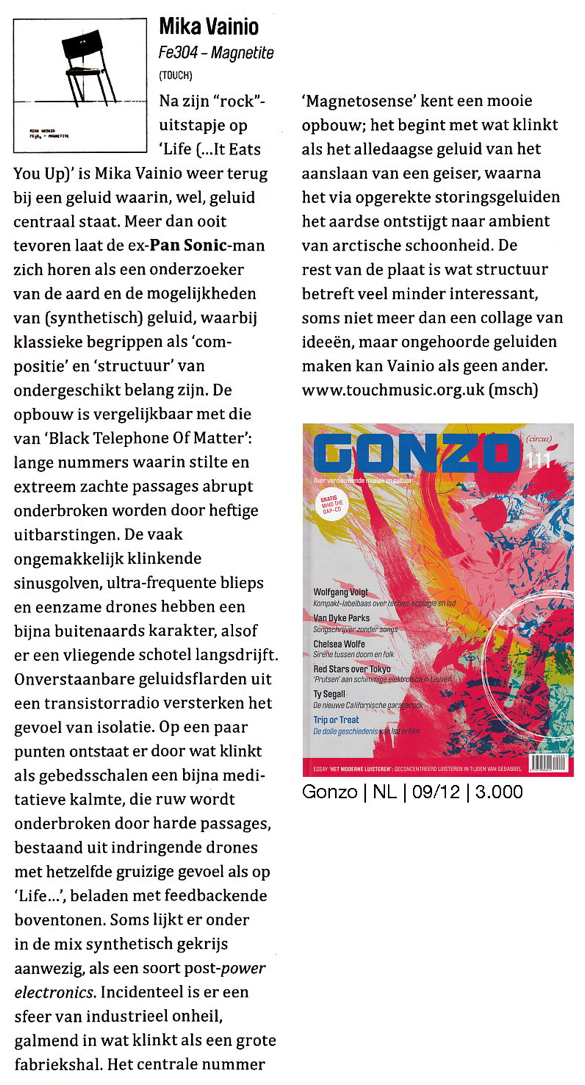
Rifraf (Belgium):
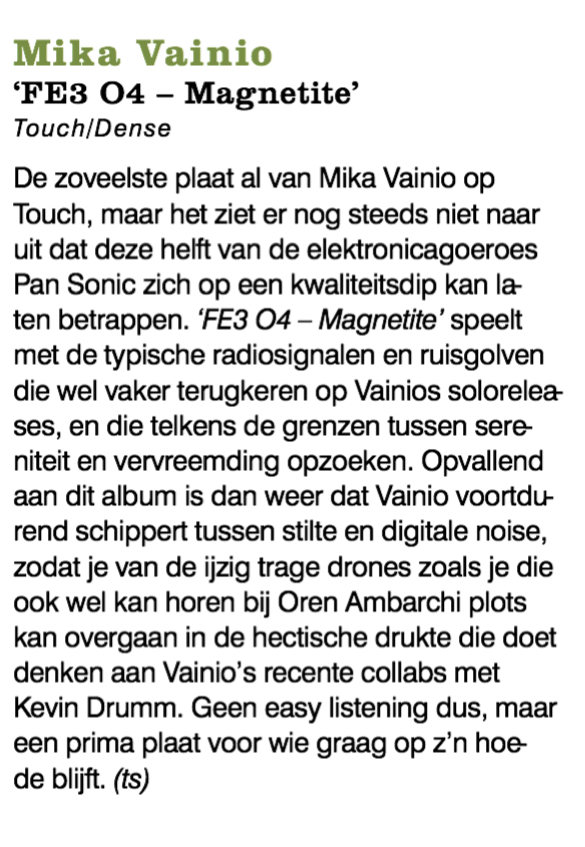
tinymixtapes (USA):
One of the most hotly sought but rarely achieved qualities of music is surprise. This phenomenon works on several layers: musicians seek to make something new and unexpected, taking the whole music world by surprise; they attempt to transcend their past works by reinventing their sound, hoping to break new ground with their fans; and, finally, they strive to imbue each piece with surprise, engaging listeners by defying expectations. It’s this third category where Mika Vainio excels on Magnetite, employing a range of compositional tools and sound sources to achieve this purpose.
Vainio mines his sonic material from the edges of the cliff of tolerance. The harshness of the textures and frequencies he employs verges on a belligerent assault. But it’s just at this moment — of the listener’s fear, or inability to go on — that Vainio relents, allowing the sounds to collapse back into silence. He doesn’t allow the listener the satisfaction of dismissal or capitulation. As soon as one senses that this will be too much, Vainio shifts, jarring the listener out of their turmoil and back into the piece. Abrasive texture thus becomes an expectation-generator, which Vainio can manipulate in order to further enthrall the listener.
Vainio’s FM radio sources can act as expectation-generators as well. Via the ear’s scanning of the radio static we realize that we are seeking language, a semantic anchor in an opaque sea of noise. But Vainio gives us only a voice, not words, either by processing the receivers into unintelligibility or by leaving them between frequency bands, there dissolving into noise. It’s in our seeking of language that we become deeply involved in the sonics of Magnetite. The process is a form of pareidolia, like seeing a face apparate in the grain of wood paneling. This process evokes curiosity, which leads us deeper into the proverbial rabbit hole. Vainio often creates huge disjunctions at the moments when we are most interested, because it’s there that he will achieve the greatest surprise.
Some textures suggest their continuation. For instance, an oscillator with a slowly evolving movement within it pushes the listener to expect a return to the zero point of the movement’s period. We expect crescendos to continue ever upwards. In quiet portions, we expect a slow rising motion out, a building up, before the music achieves peak loudness again. All of these aspects are further examples of expectation-generators, and voiding them provides further ways to fuck with the listener’s emotions. Vainio will cut a modulation off mid-period with a stabbing bass sound, or cut a crescendo off just before the peak. The quiet sections of Magnetite might give rise to further ambient sounds, or they might die off in a blast of distortion. In Vainio’s manipulation of what we expect, we become unable to rely on expectation to comfort us. This violation, which in pop music would be a kind of breach of contract, actually drives excitement, providing novel directions whenever the experience stagnates.
Perhaps the two strongest generators of expectation have little to do with the textures themselves but of their composition. These are rhythm and the repetition of phrases. Rhythm obviously creates the expectation that the sound will follow the beat; one of the ways jazz and rock music provided surprise was through syncopation, which can create tension in a rhythm like stretching a rubber band. Magnetite is not wholly arrhythmic, but its rhythms are sparse. They enter, and as soon as they develop to recognition (slow gong sounds, for instance, are common), Vainio destroys them with either unrecognizable noise or silence. Likewise with repetition. The more a phrase repeats, the more we expect it. You can guess what tends to happen to repeated phrases here: interruption, shattering, or sudden absence.
Expectation-defying music is no doubt challenging. When music conforms to most of our expectations (violating just a few to keep things interesting), it’s easy to engage with it because it speaks to known quantities. But, paradoxically, the defiance of expectation can provoke an even deeper engagement. It’s just a difficult one. Moments of surprise have an affective force that few other sensations can match. It’s the fight-or-flight response. Surprise creates fear and awe, but most of all uncertainty. When music does not conform to our memories of what music has been before it, we are uncertain where it will go. It’s not a comfortable feeling, but it’s a powerful one, especially in a world where simple formulae can yield success. Expect it, then, to continue to remain at the edge of music with people like Mika Vainio, with only a few outliers from the mainstream testing its boundaries.
hhv (Germany):
Eines muss man dem Finnen Mika Vainio lassen. Er beackert zwar seit vielen Jahren und mit unzähligen Veröffentlichungen das ewig gleiche Feld des abstrakten Klangs bzw. Noise. Doch er kann – abgesehen von einigen wenigen Ausnahmen wie sein gitarrenlastiger Vorgänger »Life (… It Eats You Up)« – einen noch immer gefangen nehmen. Auch auf »Fe3O4 Magnetite« extrahiert Vainio wieder einmal alles aus verwaschenen Radiosignalen, Klanghölzern und Sinuswellengeneratoren, Atomreaktoren und Klangschalen. Seine sieben Titel sind noch nicht einmal als echte Stücke erkennbar, sondern als Sammlung isolierter Klangvorfälle, welche durch lange Pausen fein säuberlich voneinander getrennt werden. Und somit Luft zum Atmen erhalten. Dennoch ist die Perfektion des Krachs, des Fiepens, des Rauschens und der Stille, welche die gespenstischen Momentaufnahmen durchsetzen, erneut beeindruckend. Die wenigsten Klangkünstler erreichen trotz all der modernen Plugins diese Klarheit des Klangs. Selbst im Krach bewegt sich Vainio wie ein zwanghaft-perfektionistischer Chirurg mit geschliffenem Skalpel entlang der Frequenzgrenzen. Die Kraft, welche eine Klang dadurch erhält, kann manchmal ganz schön beunruhigend sein. Kein Wunder, dass er sein Album mit einem extrem sauber austarierten Gehörsturz beendet.
Blow Up (Italy):
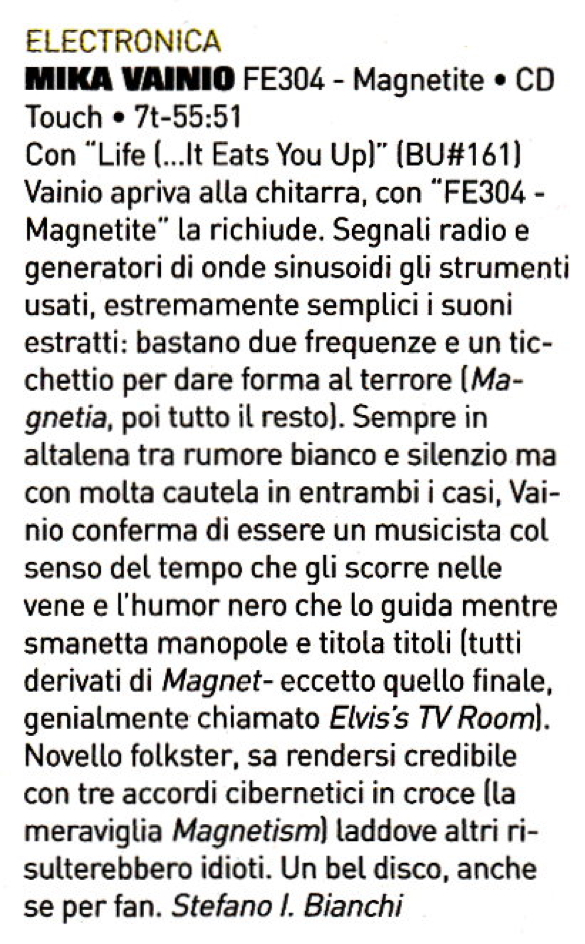
Essmaa (France):
C’était la première grosse pluie .
Elle fait remonter du sol l’odeur de la terre boueuse.
Elle agglutine au sol les feuilles flétries.
Elle se répand sur le bitume de la cour en une flaque où se reflète le ciel chargé de nuages en forme de champignon atomique.
Qu’une pluie … malgré tout.
Que de sombres nuages … malgré tout.
Il fait froid et humide
Par la fenêtre de la pièce vide, on observe la mutation du paysage. Un immense vide semble s’imposer comme le maitre des lieux. Aspirant le paysage, jetant un voile grisâtre sur les couleurs de l’automne persistantes. Résistantes, comme pour rappeler les ciels bleus & les percées de soleil.
Dans l’appartement, on entend vaguement, très loin, le bruit d’une télé. Neige cathodique. Mika Vainio fait souffler un vent glacé, en explorant à la fois le bruit et le silence.
Les carreaux sont sales, mais vaut il la peine de les laver maintenant?
Vice (USA):
Pan Sonic was part of that let’s-see-if-we-can-make-the-audience-shit-themselves-with-this-freaky-sine-wave school of noise musicians who, granted, weren’t ever much to look at but pursued a far nobler goal than their Whitehouse-biting counterparts, who were just doing it to yell a lot and get laid. Mika went a little off the rails when they split and started doing minimal glitch covers of Kate Bush under the name Ø, but this seems like he’s prodigal-sonned his way back into the grumbling, swooshy drone game. Which is good because I’ve been eating a lot of cheese this week and am stopped up like a fairground port-a-john.
popmatters (USA):
I take to the stuff on Touch’s roster because I want to hear music – or more appropriately, sounds – that I’ve never heard before. And it’s with Mika Vainio’s FE304 – Magnetite that I get more than I bargained for. On the final track “Elvis’s TV Room”, this half of Pan Sonic gives me artificial tinnitus. Dogs may twitch a little bit, George Martin would think something along the lines of been-there-done-that, but it absolutely gives me the creeps. So does the remainder of the album, titles being variations on the word “Magnetite”; “Magnetia”, “Magnetotactic”, “Magnetosphere” and so on. Part noise deconstruction, part deafening electronics and part deathly silence, FE304 – Magnetite continues Vainio’s reputation as a guy who blurs art and noise to the point of great affectation. It’s not music, but it is deep listening. [John Garrett]
Neural (Italy):
L’irreale musica della routine L’astrazione sonora del Mika Vainio di ‘Life (…It Eats You Up)’ aveva dimostrato come la musica del compositore finlandese godesse di un’anima organica viva e vegeta. Se l’esperi- mento era riuscito, il merito risiedeva nel sot- tile bilanciamento tra le parti: rumorismo ma di radice austera, misurata e rumori statici e silenzi glaciali. I contrasti continuano nel nuo- vo, eccellente disco, in cui si torna al minima- lismo dei compianti Pan Sonic e alle violenze del silenzio attenuate da scariche di rumore. È proprio questo equilibrio tra la perdita di con- tatto sonoro e la risonanza del caos a segnare ‘Fe304…’, a fermarne l’immagine tra segnali radio e deviazioni glitch in un contesto che trasuda Berlino (in cui, non a caso, è stato registrato tra il2011eil2012)e il suo calore distaccato e decadente. ‘Fe304…’ è un gioco elet- tronico che ha come obiettivo l’astrazione del- la routine; è espressionismo avanguardista scomodo perché reale, è la poesia di un bri- ciolo di magnetite. Basta saper ascoltare. [Alex Franquelli]
Rockdeluxe (Italy):

Etherreal (France):
FE3O4 – Magnetite est le 5ème album de Mika Vainio pour le label Touch après Black Telephone of Matter. Après s’être essayé à la guitare chez Editions Mego en 2011 on le retrouve dans une formule plus habituelle, travaillant sur des contrastes entre bruit et apaisement.
On retrouve très vite le style de l’artiste avec Magnetia qui s’ouvre sur des petits coups de bois et légers grincements métalliques qui restent très doux et lumineux. Et puis brusquement une basse électronique se met à ronronner, redouble de puissance pour se transformer en un drone lourd et épais. Imperturbables, les sonorités acoustiques poursuivent leurs tintements, régulières comme un métronome, et une certaine poésie, inexplicable, presque magique, se dégage de cette conjugaison entre puissance et fragilité, l’ensemble révélant une certaine sérénité.
Le procédé varie légèrement sur chaque morceau. Il pourra paraître un peu plus extrême sur Magnetotactic, tant par la nature et l’exubérance des déflagrations sonores que par le calme des silences et autres sonorités à la limite de l’audible, et on le trouvera presque ludique sur Magnetosphere où Mika Vainio nous surprend en changeant de vocabulaire puisqu’un un long passage d’ondes radio est ici brusquement interrompu par le bruit assourdissant d’un train passant à grande vitesse.
Mais le meilleur reste à venir avec Magnetosense qui emportera très certainement notre préférence. Ce titre charnière qui reprend plus ou moins les mêmes éléments se révèle être une superbe et étonnante pièce ambient sur laquelle des ronronnements de machines se transforment en un avion traversant le ciel. Là dessus quelques tonalités électroniques, telles des soupirs, esquissent une douce mélodie ambient, flirtant avec un certain krautrock.
On revient en terrain connu sur la deuxième moitié de l’album, alternant entre acoustique et électronique tout en révélant son lot de surprises comme cette ambient spatiale, digne d’un film de science-fiction sur Magnetism, cette longue séquence à la frontière du bol tibétain et du gong sur Magnetosome ou encore ces ondes radios ou vieux vinyles qui sont certainement des enregistrements d’une émission télé si on se fie au seul titre “non magnétique” : Elvis’s TV Room.
Les fans du finlandais ne seront pas déçus, FE3O4 – Magnetite se situant dans la droite ligne des précédentes productions de Mika Vainio. [Fabrice Allard]












